cooling Lancia Ypsilon 2012 Owner handbook (in English)
[x] Cancel search | Manufacturer: LANCIA, Model Year: 2012, Model line: Ypsilon, Model: Lancia Ypsilon 2012Pages: 307, PDF Size: 13.3 MB
Page 45 of 307

toward the body and the side windowstoward the body, the side windows and the
feettoward the feet onlytoward the feet and the windscreentoward the windscreen only
D Heated rear window activation/deactivation
button.
When the function is active, the LED on the
button is lit up.
In order to maintain battery efficiency, the
function is automatically deactivated after about
20 minutes.
E Fan speed adjustment knob.
NoteTo stop the air flow from the vents turn the
knob to 0.
F climate control compressor on/off button. Press
the button to activate the climate control
system; the LED on the button switches on
contemporarily (this enables rapid cooling of
the passenger compartment).Fast windscreen and front side window
demisting/defrosting (MAX-DEF)
Proceed as follows:
❒turn knob A to the red section;
❒move slider B to
;
❒turn knob C to
;
❒turn knob E to 4 (maximum fan speed).
IMPORTANT The climate control system is very
useful for speeding up demisting since it
dehumidifies the air. Adjust the controls as
described above and press button
to activate the
climate control system (the LED on the button
will light up).
43GETTING TO
KNOW YOUR CARSAFETY
STARTING AND
DRIVING
WARNING LIGHTS
AND MESSAGES
IN AN EMERGENCY
SERVICING AND
MAINTENANCE
TECHNICAL
SPECIFICATIONS
INDEX
C Air distribution knob
Page 50 of 307
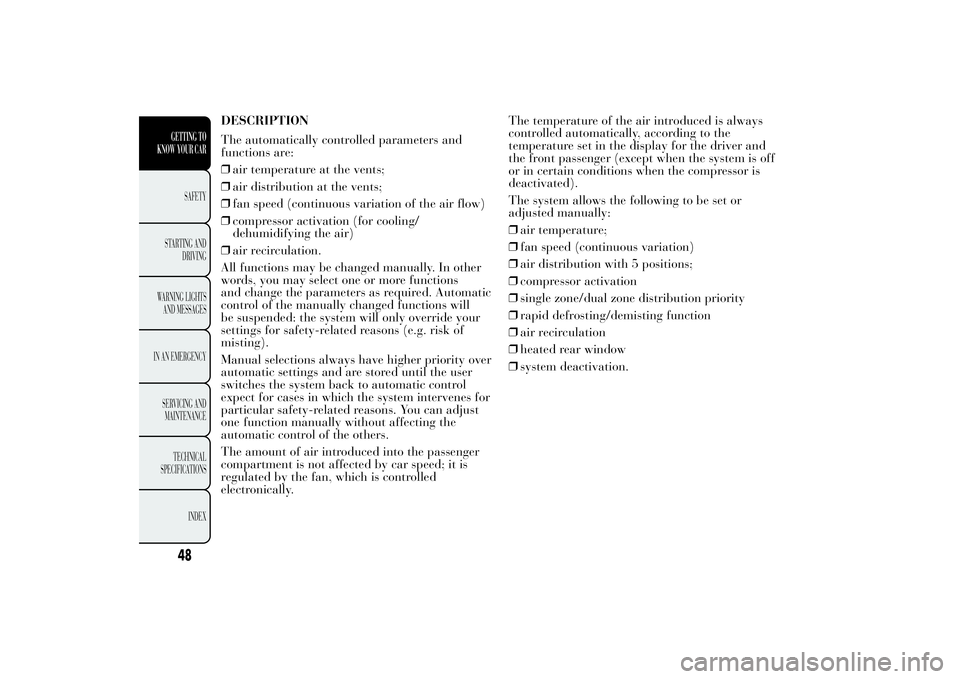
DESCRIPTION
The automatically controlled parameters and
functions are:
❒air temperature at the vents;
❒air distribution at the vents;
❒fan speed (continuous variation of the air flow)
❒compressor activation (for cooling/
dehumidifying the air)
❒air recirculation.
All functions may be changed manually. In other
words, you may select one or more functions
and change the parameters as required. Automatic
control of the manually changed functions will
be suspended: the system will only override your
settings for safety-related reasons (e.g. risk of
misting).
Manual selections always have higher priority over
automatic settings and are stored until the user
switches the system back to automatic control
expect for cases in which the system intervenes for
particular safety-related reasons. You can adjust
one function manually without affecting the
automatic control of the others.
The amount of air introduced into the passenger
compartment is not affected by car speed; it is
regulated by the fan, which is controlled
electronically.The temperature of the air introduced is always
controlled automatically, according to the
temperature set in the display for the driver and
the front passenger (except when the system is off
or in certain conditions when the compressor is
deactivated).
The system allows the following to be set or
adjusted manually:
❒air temperature;
❒fan speed (continuous variation)
❒air distribution with 5 positions;
❒compressor activation
❒single zone/dual zone distribution priority
❒rapid defrosting/demisting function
❒air recirculation
❒heated rear window
❒system deactivation.
48GETTING TO
KNOW YOUR CAR
SAFETY
STARTING AND
DRIVING
WARNING LIGHTS
AND MESSAGES
IN AN EMERGENCY
SERVICING AND
MAINTENANCE
TECHNICAL
SPECIFICATIONS
INDEX
Page 53 of 307
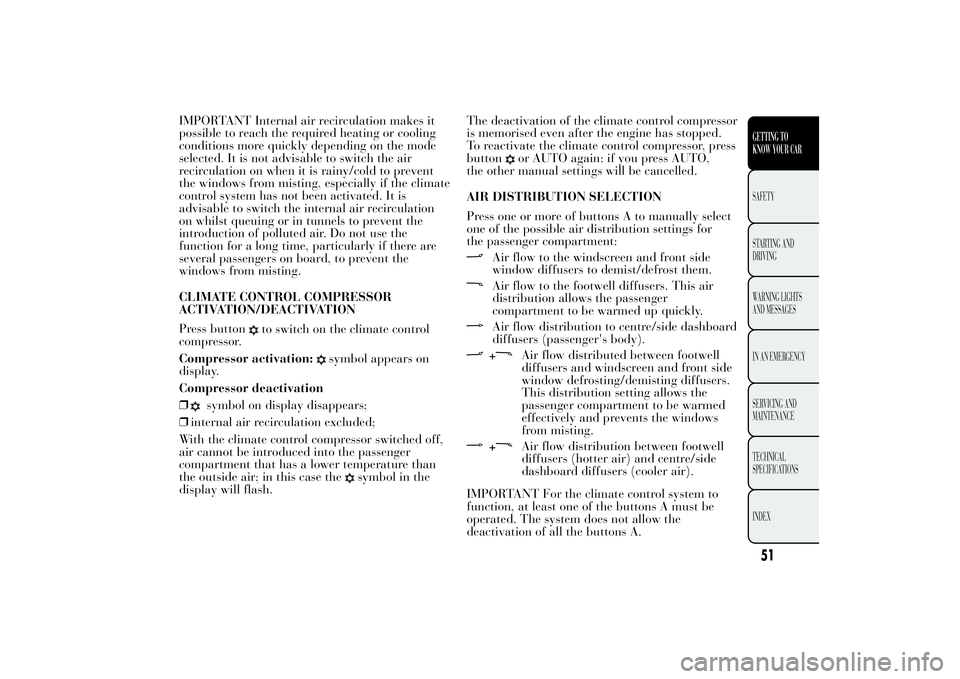
IMPORTANT Internal air recirculation makes it
possible to reach the required heating or cooling
conditions more quickly depending on the mode
selected. It is not advisable to switch the air
recirculation on when it is rainy/cold to prevent
the windows from misting, especially if the climate
control system has not been activated. It is
advisable to switch the internal air recirculation
on whilst queuing or in tunnels to prevent the
introduction of polluted air. Do not use the
function for a long time, particularly if there are
several passengers on board, to prevent the
windows from misting.
CLIMATE CONTROL COMPRESSOR
ACTIVATION/DEACTIVATION
Press button
to switch on the climate control
compressor.
Compressor activation:
symbol appears on
display.
Compressor deactivation
❒
symbol on display disappears;
❒internal air recirculation excluded;
With the climate control compressor switched off,
air cannot be introduced into the passenger
compartment that has a lower temperature than
the outside air; in this case the
symbol in the
display will flash.The deactivation of the climate control compressor
is memorised even after the engine has stopped.
To reactivate the climate control compressor, press
button
or AUTO again: if you press AUTO,
the other manual settings will be cancelled.
AIR DISTRIBUTION SELECTION
Press one or more of buttons A to manually select
one of the possible air distribution settings for
the passenger compartment:
Air flow to the windscreen and front side
window diffusers to demist/defrost them.Air flow to the footwell diffusers. This air
distribution allows the passenger
compartment to be warmed up quickly.Air flow distribution to centre/side dashboard
diffusers (passenger's body).+
Air flow distributed between footwell
diffusers and windscreen and front side
window defrosting/demisting diffusers.
This distribution setting allows the
passenger compartment to be warmed
effectively and prevents the windows
from misting.
+
Air flow distribution between footwell
diffusers (hotter air) and centre/side
dashboard diffusers (cooler air).
IMPORTANT For the climate control system to
function, at least one of the buttons A must be
operated. The system does not allow the
deactivation of all the buttons A.
51GETTING TO
KNOW YOUR CARSAFETY
STARTING AND
DRIVING
WARNING LIGHTS
AND MESSAGES
IN AN EMERGENCY
SERVICING AND
MAINTENANCE
TECHNICAL
SPECIFICATIONS
INDEX
Page 55 of 307
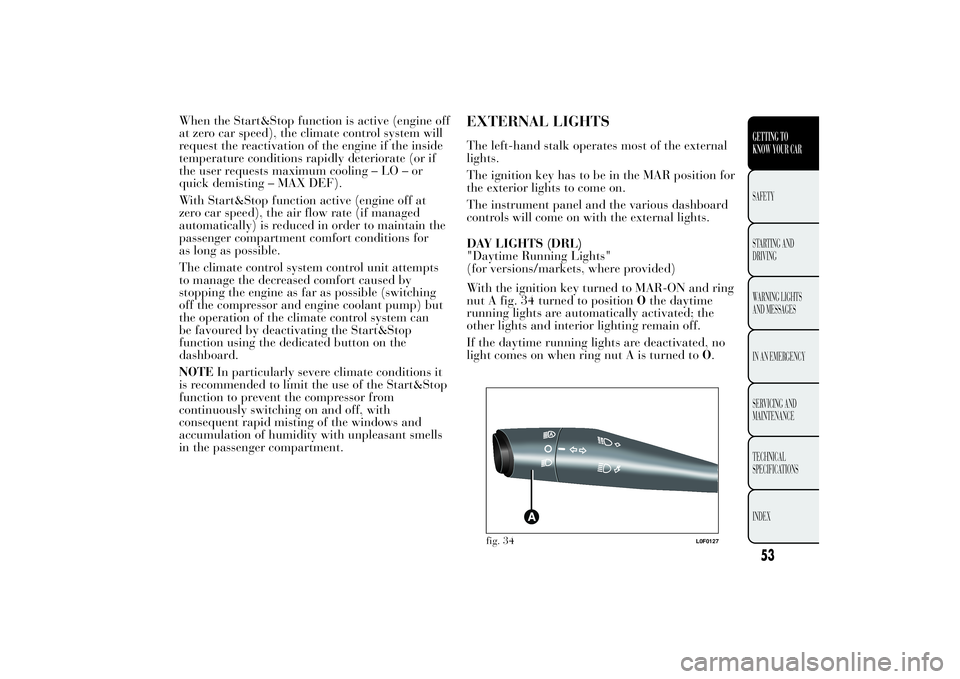
When the Start&Stop function is active (engine off
at zero car speed), the climate control system will
request the reactivation of the engine if the inside
temperature conditions rapidly deteriorate (or if
the user requests maximum cooling – LO – or
quick demisting – MAX DEF).
With Start&Stop function active (engine off at
zero car speed), the air flow rate (if managed
automatically) is reduced in order to maintain the
passenger compartment comfort conditions for
as long as possible.
The climate control system control unit attempts
to manage the decreased comfort caused by
stopping the engine as far as possible (switching
off the compressor and engine coolant pump) but
the operation of the climate control system can
be favoured by deactivating the Start&Stop
function using the dedicated button on the
dashboard.
NOTEIn particularly severe climate conditions it
is recommended to limit the use of the Start&Stop
function to prevent the compressor from
continuously switching on and off, with
consequent rapid misting of the windows and
accumulation of humidity with unpleasant smells
in the passenger compartment.
EXTERNAL LIGHTSThe left-hand stalk operates most of the external
lights.
The ignition key has to be in the MAR position for
the exterior lights to come on.
The instrument panel and the various dashboard
controls will come on with the external lights.
DAY LIGHTS (DRL)
"Daytime Running Lights"
(for versions/markets, where provided)
With the ignition key turned to MAR-ON and ring
nut A fig. 34 turned to positionOthe daytime
running lights are automatically activated; the
other lights and interior lighting remain off.
If the daytime running lights are deactivated, no
light comes on when ring nut A is turned toO.
fig. 34
L0F0127
53GETTING TO
KNOW YOUR CARSAFETY
STARTING AND
DRIVING
WARNING LIGHTS
AND MESSAGES
IN AN EMERGENCY
SERVICING AND
MAINTENANCE
TECHNICAL
SPECIFICATIONS
INDEX
Page 155 of 307

STORING THE CARIf the car is to be left inactive for longer than a
month, the following precautions should be
observed:
❒park the car in covered, dry and if possible
well-ventilated premises and slightly open
the windows;
❒engage a gear and check that the handbrake is
not engaged;
❒disconnect the negative battery terminal (for
versions with Start&Stop system refer to the
paragraph "Start&Stop system" in the chapter
"Knowing your car"); If the battery is not
disconnected the from the electrical system,
check its charge every thirty days;❒clean and protect the painted parts using
protective wax;
❒clean and protect the shiny metal parts using
special compounds available commercially;
❒sprinkle talcum powder on the rubber
windscreen and rear window wiper blades and
lift them off the glass;
❒cover the car with a cloth or perforated plastic
sheet. Do not use sheets of non-perforated
plastic as they do not allow moisture on the car
body to evaporate;
❒inflate tyres to +0.5 bar above the standard
specified pressure and check it at intervals;
❒do not drain the engine cooling system.
153GETTING TO KNOW
YOUR CAR
SAFETYSTARTING AND
DRIVINGWARNING LIGHTS
AND MESSAGES
IN AN EMERGENCY
SERVICING AND
MAINTENANCE
TECHNICAL
SPECIFICATIONS
INDEX
Page 197 of 307
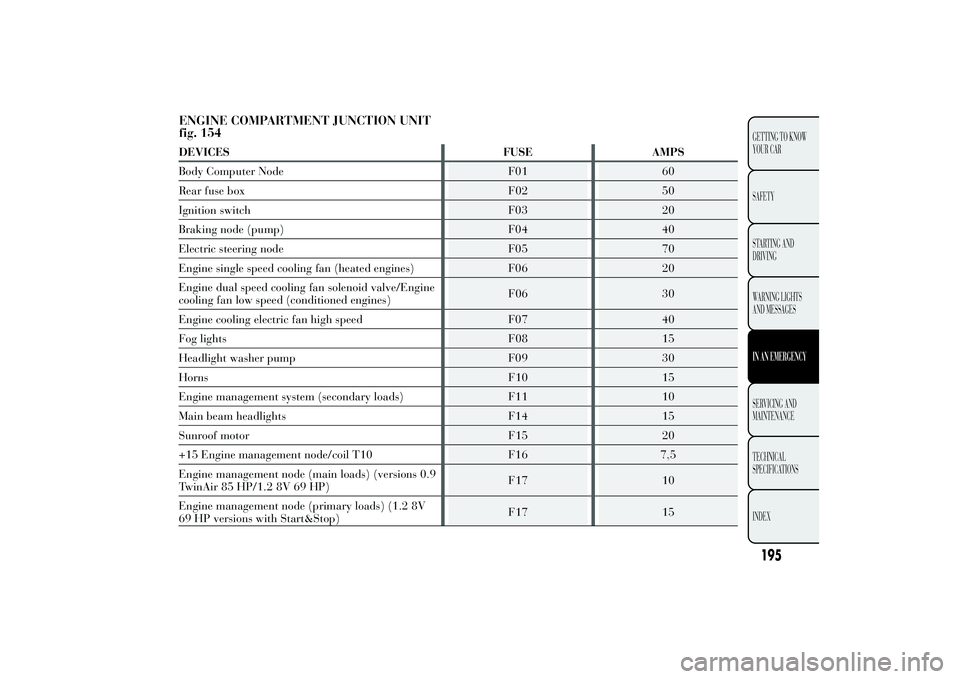
ENGINE COMPARTMENT JUNCTION UNIT fig. 154
195GETTING TO KNOW YOUR CAR SAFETYSTARTING AND DRIVING WARNING LIGHTS AND MESSAGESIN AN EMERGENCYSERVICING ANDMAINTENANCE TECHNICAL SPECIFICATIONS INDEX DEVICES FUSE AMPS Body Computer Node F01 60Rear fuse box F02 50Ignition switch F03 20Braking node (pump) F04 40Electric steering node F05 70Engine single speed cooling fan (heated engines) F06 20Engine dual speed cooling fan solenoid valve/Engine cooling fan low speed (conditioned engines)
F06 30
Engine cooling electric fan high speed F07 40 Fog lights F08 15Headlight washer pump F09 30Horns F10 15Engine management system (secondary loads) F11 10Main beam headlights F14 15Sunroof motor F15 20+15 Engine management node/coil T10 F16 7,5Engine management node (main loads) (versions 0.9 TwinAir 85 HP/1.2 8V 69 HP)
F17 10
Engine management node (primary loads) (1.2 8V 69 HP versions with Start&Stop)
F17 15
Page 207 of 307
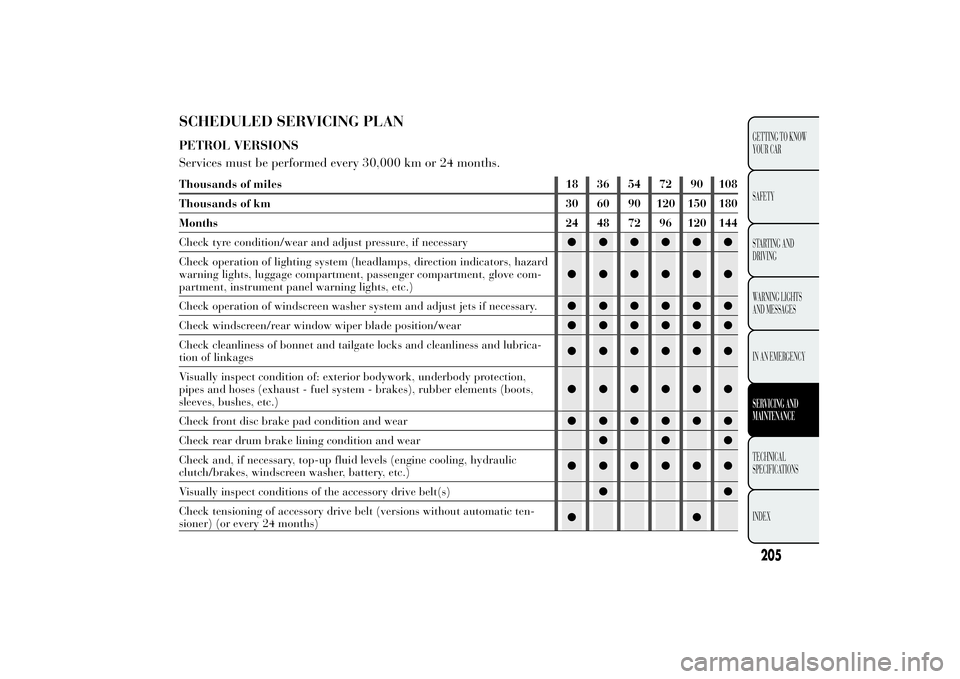
SCHEDULED SERVICING PLANPETROL VERSIONS
Services must be performed every 30,000 km or 24 months.Thousands of miles 18 36 54 72 90 108
Thousands of km 30 60 90 120 150 180
Months 24 48 72 96 120 144
Check tyre condition/wear and adjust pressure, if necessary●●●●●●
Check operation of lighting system (headlamps, direction indicators, hazard
warning lights, luggage compartment, passenger compartment, glove com-
partment, instrument panel warning lights, etc.)●●●●●●
Check operation of windscreen washer system and adjust jets if necessary.●●●●●●
Check windscreen/rear window wiper blade position/wear●●●●●●
Check cleanliness of bonnet and tailgate locks and cleanliness and lubrica-
tion of linkages●●●●●●
Visually inspect condition of: exterior bodywork, underbody protection,
pipes and hoses (exhaust - fuel system - brakes), rubber elements (boots,
sleeves, bushes, etc.)●●●●●●
Check front disc brake pad condition and wear●●●●●●
Check rear drum brake lining condition and wear●●●
Check and, if necessary, top-up fluid levels (engine cooling, hydraulic
clutch/brakes, windscreen washer, battery, etc.)●●●●●●
Visually inspect conditions of the accessory drive belt(s)●●
Check tensioning of accessory drive belt (versions without automatic ten-
sioner) (or every 24 months)●●
205GETTING TO KNOW
YOUR CAR
SAFETY
STARTING AND
DRIVING
WARNING LIGHTS
AND MESSAGES
IN AN EMERGENCYSERVICING AND
MAINTENANCETECHNICAL
SPECIFICATIONS
INDEX
Page 209 of 307
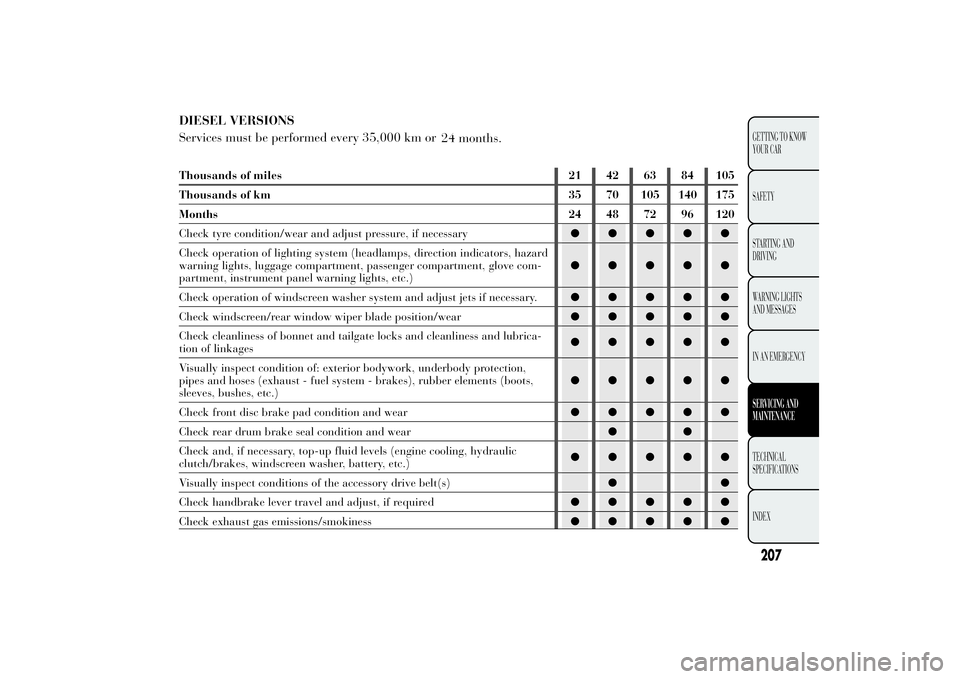
DIESEL VERSIONS
Services must be performed every 35,000 km or
24 months.Thousands of miles 21 42 63 84 105
Thousands of km 35 70 105 140 175
Months 24 48 72 96 120
Check tyre condition/wear and adjust pressure, if necessary●●●●●
Check operation of lighting system (headlamps, direction indicators, hazard
warning lights, luggage compartment, passenger compartment, glove com-
partment, instrument panel warning lights, etc.)●●●●●
Check operation of windscreen washer system and adjust jets if necessary.●●●●●
Check windscreen/rear window wiper blade position/wear●●●●●
Check cleanliness of bonnet and tailgate locks and cleanliness and lubrica-
tion of linkages●●●●●
Visually inspect condition of: exterior bodywork, underbody protection,
pipes and hoses (exhaust - fuel system - brakes), rubber elements (boots,
sleeves, bushes, etc.)●●●●●
Check front disc brake pad condition and wear●●●●●
Check rear drum brake seal condition and wear●●
Check and, if necessary, top-up fluid levels (engine cooling, hydraulic
clutch/brakes, windscreen washer, battery, etc.)●●●●●
Visually inspect conditions of the accessory drive belt(s)●●
Check handbrake lever travel and adjust, if required●●●●●
Check exhaust gas emissions/smokiness●●●●●
207GETTING TO KNOW
YOUR CAR
SAFETY
STARTING AND
DRIVING
WARNING LIGHTS
AND MESSAGES
IN AN EMERGENCYSERVICING AND
MAINTENANCETECHNICAL
SPECIFICATIONS
INDEX
Page 217 of 307

ENGINE COOLANT
The coolant level must be checked when the
engine is cold and must be between the MIN and
MAX marks on the reservoir.
If the level is too low, undo reservoir cap C (see
previous pages) and add the fluid described in the
chapter "Technical Specifications".
PARAFLU
UP
anti-freeze is used in the
engine cooling system. Use the same
fluid as in the cooling system when
topping up. PARAFLU
UP
may not be mixed
with any other types of fluids. If this occurs,
do not start the engine and contact your
Lancia Dealership immediately.
WARNING
The cooling system is pressurised. If
necessary, only replace the cap with
another genuine one or the operation of the
system may be adversely affected. Do not
remove the reservoir cap when the engine is
hot: you risk scalding yourself.WINDSCREEN/REAR WINDOW WASHING
FLUID
If the level is too low, raise reservoir cap D (see
previous pages) and add the fluid described in the
chapter "Technical Specifications".
WARNING
Do not travel if the windscreen
washer reservoir is empty: using the
windscreen washer is essential for
improving visibility. Some commercial
windscreen washer additives are flammable.
The engine compartment contains hot
components which may set it on fire.
215GETTING TO KNOW
YOUR CAR
SAFETY
STARTING AND
DRIVING
WARNING LIGHTS
AND MESSAGES
IN AN EMERGENCYSERVICING AND
MAINTENANCETECHNICAL
SPECIFICATIONS
INDEX
Page 247 of 307
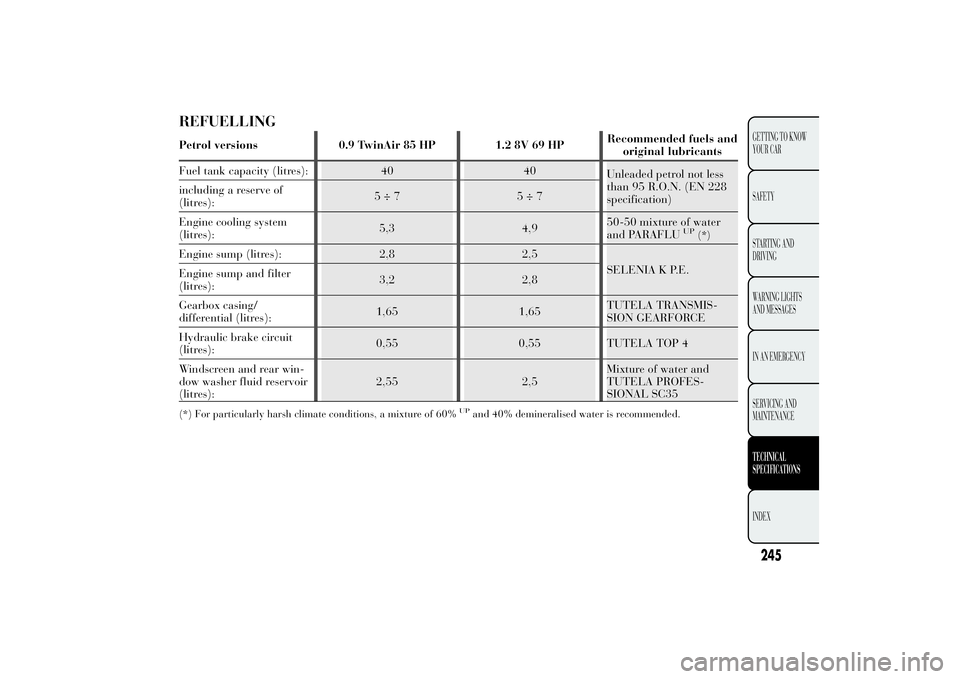
REFUELLINGPetrol versions 0.9 TwinAir 85 HP 1.2 8V 69 HPRecommended fuels and
original lubricants
Fuel tank capacity (litres): 40 40
Unleaded petrol not less
than 95 R.O.N. (EN 228
specification) including a reserve of
(litres):5÷7 5÷7
Engine cooling system
(litres):5,3 4,950-50 mixture of water
and PARAFLU
UP
(*)
Engine sump (litres): 2,8 2,5
SELENIA K P.E.
Engine sump and filter
(litres):3,2 2,8
Gearbox casing/
differential (litres):1,65 1,65TUTELA TRANSMIS-
SION GEARFORCE
Hydraulic brake circuit
(litres):0,55 0,55 TUTELA TOP 4
Windscreen and rear win-
dow washer fluid reservoir
(litres):2,55 2,5Mixture of water and
TUTELA PROFES-
SIONAL SC35(*) For particularly harsh climate conditions, a mixture of 60%
UP
and 40% demineralised water is recommended.
245GETTING TO KNOW
YOUR CAR
SAFETY
STARTING AND
DRIVING
WARNING LIGHTS
AND MESSAGES
IN AN EMERGENCY
SERVICING AND
MAINTENANCETECHNICAL
SPECIFICATIONSINDEX